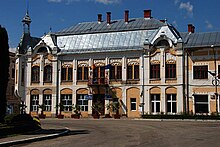Năsăud
|
Năsăud Nussdorf Naszód |
||||
|
||||
| Basic data | ||||
|---|---|---|---|---|
| State : |
|
|||
| Historical region : | Transylvania | |||
| Circle : | Bistrița-Năsăud | |||
| Coordinates : | 47 ° 17 ' N , 24 ° 24' E | |||
| Time zone : | EET ( UTC +2) | |||
| Height : | 331 m | |||
| Area : | 43.25 km² | |||
| Residents : | 9,587 (October 20, 2011) | |||
| Population density : | 222 inhabitants per km² | |||
| Postal code : | 425200 | |||
| Telephone code : | (+40) 02 63 | |||
| License plate : | BN | |||
| Structure and administration (as of 2016) | ||||
| Community type : | city | |||
| Structure : | Năsăud, Liviu Rebreanu , Lușca | |||
| Mayor : | Nicolae-Mircea Romocea ( PSD ) | |||
| Postal address : | Piața Unirii, no. 15 loc. Năsăud, jud. Bistrița-Năsăud, RO-425200 |
|||
| Website : | ||||
Năsăud ( German Nussdorf , Nussendorf ; Hungarian Naszód ) is a town in the Bistrița-Năsăud district in Romania .
location
Năsăud is located in northern Transylvania on the Great Somesch River , about 20 km north of the district capital Bistrița ( Bistritz ).
history
The name Năsăud probably comes from the Slavic “nas voda”, meaning “near the water”. Another name is Nussdorf ("walnut tree village"), the Transylvanian-Saxon name of the city in the Middle Ages.
Năsăud was a Habsburg border town.
Năsăud was an industrial town from the 20th century, both during the communist era and after the 1989 revolution.
Some buildings from the late 18th and early 19th centuries still stand in Năsăud. Noteworthy in this context are the Greek Catholic Church and the former military headquarters of the Habsburg era, now a museum.
population
Almost exclusively Romanians live in the community . In the 2002 census, 10,088 of the 10,582 inhabitants at that time declared themselves to be Romanian, 100 to Hungarian , 12 to German , 3 to Ukrainian , 2 to Russian , 1 to Turkish and 2 to various nationalities. 374 called themselves Roma .
traffic
The national roads Drum național 17C run through Năsăud to the city of Bistrița and Drum național 17D , which follows the river Someșul Mare upwards. The Beclean pe Someş – Rodna Veche railway runs here .
Attractions
- The Grăniceresc Năsăudean Museum (formerly the seat of the "Border Regiment 2"), built in 1762, renovated in 1851, is a listed building.
- Memorial Museum for Liviu Rebreanu built in 1957, is a listed building.
- Memorial house for George Coșbuc
- Statue "Lupa Capitolina", symbol of the Romanian people, donated by Dr. George Traian Dascăl and his wife Nadia
- Heroes monument for the Romanian soldiers of the First World War (2.50 m high)
- The orthodox church Sfântul Ierarh Nicolae is a listed building
- The Mihai Eminescu School , built between 1929 and 1933, is a listed building.
- The George Coșbuc School , built between 1887 and 1888, is a listed building.
Personalities
Born in Năsăud
- Veronica Micle (1850-1889), poet
- Iuliu Moisil (1859–1947), professor, 1943 member of the Romanian Academy .
- Constantin Moisil (1876–1958), numismat, 1948 member of the Romanian Academy.
- Joel Brand (1906–1964), left-wing socialist Zionist
- Sergiu Homei (* 1987), football player
Connected to the city
- Grigore Silași (1836-1897), who died here, was a linguist, university professor, and in 1877 an honorary member of the Romanian Academy.
- Virgil Șotropa (1867–1954), died here, was a philologist and professor and in 1943 an honorary member of the Romanian Academy .
- Miron Cristea (1868–1939), here high school, was the first patriarch of the Romanian Orthodox Church, in 1919 honorary member of the Romanian Academy
- Nicolae Bălan (1882–1955), born in Blăjenii de Sus , was metropolitan of Transylvania
- Dumitru Protase (* 1926), here high school, is a historian and archaeologist and has been an honorary member of the Romanian Academy since 2003.
Web links
Individual evidence
- ↑ 2011 census in Romania ( MS Excel ; 1.3 MB)
- ^ Censuses in Transylvania 1850-2002
- ↑ a b c d List of historical monuments of the Romanian Ministry of Culture, updated 2015 (PDF; 12.7 MB; Romanian)
- ↑ The Liviu Rebreanu Museum on the Complexul Muzeal Bistrița-Năsăud website
- ↑ Ministerul Culturii: nr Ordinul. 3810/2016. lege5.ro, October 20, 2016, accessed December 14, 2018 (Romanian).
- ↑ Information on Veronica Micle at neamt.ro (Romanian)
- ↑ Information on Iuliu Moisil from Academia Română accessed on February 17, 2017 (Romanian)
- ↑ Information on Constantin Moisil from Academia Română accessed on February 17, 2017 (Romanian)
- ↑ Szilasi Gergely at mek.oszk.hu accessed on February 17, 2017 (Hungarian)
- ↑ Information on Grigore Silași from Academia Română accessed on February 17, 2017 (Romanian)
- ↑ Information on Virgil Șotropa from Academia Română accessed on February 17, 2017 (Romanian)
- ↑ Information on Miron Cristea from Academia Română accessed on February 17, 2017 (Romanian)
- ↑ Nicolae Bălan from crestinortodox.ro accessed on February 17, 2017 (Romanian)







